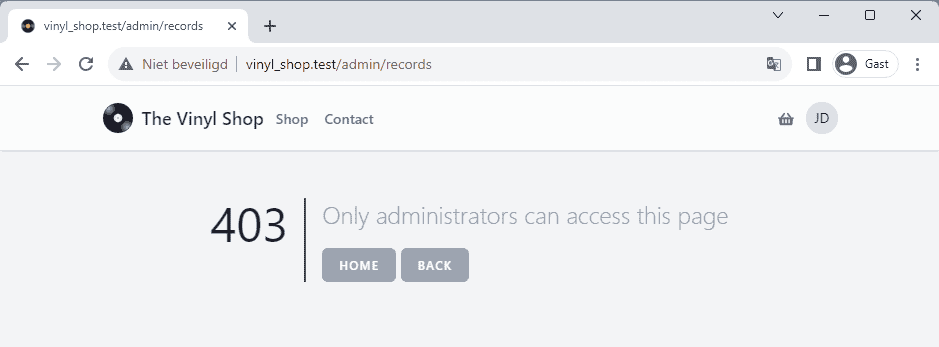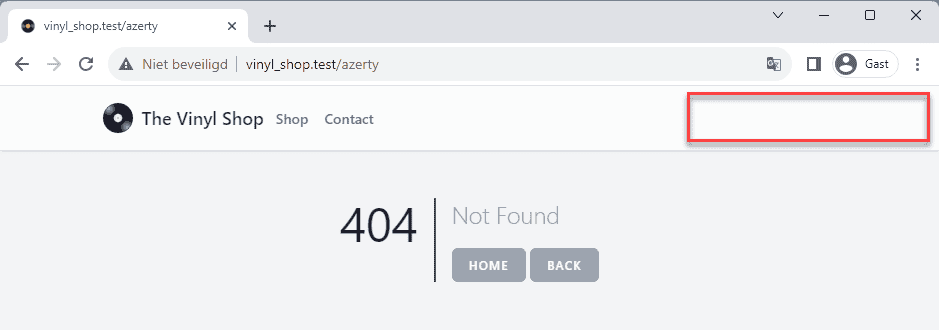Appearance
Custom error pages
- In the previous sections we saw different error pages:
- A 404 error if the page does not exist: http://vinyl_shop.test/azerty
- A 403 error if the user has no admin rights (e.g. jane.doe@example.com): http://vinyl_shop.test/admin/records
- A 419 error when the
@CSRFtoken is missing in the form - A 500 error is a generic error page when something goes wrong AND the
APP_DEBUGenvironment variable is set tofalse
- These are the default Laravel error pages with no navigation
- It's time to update some of them with our own template ...
Publish Laravel error pages
- Use the
php artisan vendor:publish --tag=laravel-errorscommand to publish the default Laravel error pages - All error pages are now available in the
resources/views/errorsfolder - Open, for example, the resources/views/errors/404.blade.php file
- This and all other error pages
@extendstheerrors::minimaltemplate, located in the same folder
REMARKS
Laravel actually has two ways of creating layout templates
- Component based layouts:
- This is the "modern" way of creating layouts (like we did in the previous sections)
- It uses (named) slots like
<x-slot name='nameOfTheGap'>to inject content into the layout
- Layouts using template inheritance:
- This is the "old" way of creating layouts (like the template used for the error pages)
- It uses
@section('nameOfTheGap', 'content')to inject content into the@yield('nameOfTheGap')slot in the layout template
Rerun vite
- After publishing the default Laravel error pages it is necessary to restart the compilation (Vite), otherwise the Tailwind classes aren't interpreted and you won't get the expected lay-out
Update error pages template
- If we modify the resources/views/errors/minimal.blade.php file, all error pages will be updated because they are using this template
- Open the resources/views/errors/minimal.blade.php file and replace the content with the following code:
- The layout is now based on the
<x-vinylshop-layout>template - But we keep the
@yield('code')and the@yield('message')from the original template to inject the error code and message
- The layout is now based on the
php
<x-vinylshop-layout>
<x-slot name="title"></x-slot>
<div class="grid grid-rows-2 grid-flow-col gap-4">
<p class="row-span-2 text-5xl text-right border-r-2 border-gray-700 pr-4">
@yield('code')
</p>
<p class="text-2xl font-light text-gray-400">
@yield('message')
</p>
<div>
<x-button class="!bg-gray-400 hover:!bg-gray-800">
<a href="{{ route('home') }}">Home</a>
</x-button>
<x-button class="!bg-gray-400 hover:!bg-gray-800">
<a href="#" onclick="window.history.back();">Back</a>
</x-button>
</div>
</div>
</x-vinylshop-layout><x-vinylshop-layout>
<x-slot name="title"></x-slot>
<div class="grid grid-rows-2 grid-flow-col gap-4">
<p class="row-span-2 text-5xl text-right border-r-2 border-gray-700 pr-4">
@yield('code')
</p>
<p class="text-2xl font-light text-gray-400">
@yield('message')
</p>
<div>
<x-button class="!bg-gray-400 hover:!bg-gray-800">
<a href="{{ route('home') }}">Home</a>
</x-button>
<x-button class="!bg-gray-400 hover:!bg-gray-800">
<a href="#" onclick="window.history.back();">Back</a>
</x-button>
</div>
</div>
</x-vinylshop-layout>1
2
3
4
5
6
7
8
9
10
11
12
13
14
15
16
17
18
19
2
3
4
5
6
7
8
9
10
11
12
13
14
15
16
17
18
19
- Jane Doe is not an admin, so she should not be able to access the admin/records pages

Session on 404 error page
- Even if you are logged in, the user navigation on the right is missing on the 404 page (while on the 403 and 500 error pages there's no problem)
- This is because Laravel doesn't load the session on a regular 404 error and therefore doesn't know anything of the auth state (more details about sessions later in this course)
- In order to not confuse the user, it is better to remove the right navigation completely
- Open the resources/views/errors/404.blade.php file
- Push a script to script stack:
php
@extends('errors::minimal')
@section('title', __('Not Found'))
@section('code', '404')
@section('message', __('Not Found'))
@push('script')
<script>
// remove the last div inside the nav tag
document.querySelector('header nav div:last-child').remove();
</script>
@endpush@extends('errors::minimal')
@section('title', __('Not Found'))
@section('code', '404')
@section('message', __('Not Found'))
@push('script')
<script>
// remove the last div inside the nav tag
document.querySelector('header nav div:last-child').remove();
</script>
@endpush1
2
3
4
5
6
7
8
9
10
11
12
2
3
4
5
6
7
8
9
10
11
12
